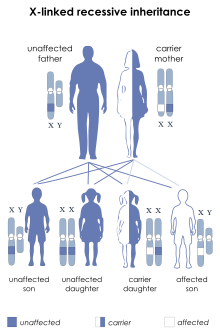Ichthyosis follicularis with alopecia and photophobia syndrome
| IFAP syndrome | |
|---|---|
 | |
| Ichthyosis follicularis with alopecia and photophobia syndrome is inherited via X-linked recessive manner(though other forms of inheritance have occurred)[1] | |
| Specialty | Medical genetics |
IFAP syndrome is an extremely rare genetic syndrome. It is also known as Ichthyosis follicularis, alopecia, and photophobia syndrome or simply ichthyosis follicularis.[2]: 564 It is extremely rare: there were only 10 known cases (all male) in 1998.[3]
Symptoms
The main symptoms are given by its name: dry, scaly skin (ichthyosis), absence of hair (atrichia) and excessive sensitivity to light (photophobia). Additional features include short stature, mental retardation, seizures and a tendency for respiratory infections.[3]
Genetics
Most cases are X-linked recessive but there may be as many as three types. As well as a classical X-linked form, there is another type where females are partially affected and another where females have full IFAP symptoms. The gene or genes causing this disease are not known.[3]
Diagnosis
Diagnosis is based on appearance and family history. KID syndrome or keratosis follicularis spinulosa decalvans have some similar symptoms and must be eliminated.[4]
Management
This section is empty. You can help by adding to it. (July 2017) |
See also
References
- ^ "OMIM Entry - # 308205 - IFAP SYNDROME WITH OR WITHOUT BRESHECK SYNDROME". omim.org. Retrieved 21 July 2017.
- ^ James, William; Berger, Timothy; Elston, Dirk (2005). Andrews' Diseases of the Skin: Clinical Dermatology. (10th ed.). Saunders. ISBN 0-7216-2921-0.
- ^ a b c OMIM (Online Mendelian Inheritance in Man), Johns Hopkins University, Ichthyosis follicularis, atrichia and photophobia
- ^ Boente M del, Bibas-Bonet H, Coronel AM, Asial RA; Atrichia, ichthyosis, follicular hyperkeratosis, chronic candidiasis, keratitis, seizures, mental retardation and inguinal hernia: a severe manifestation of IFAP syndrome?, European Journal of Dermatology. Volume 10, Number 2, 98-102, March 2000
